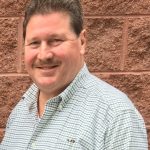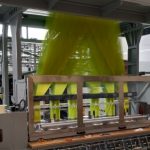16 Mar Engineer Spotlight: Cortland Biomedical’s Ed Tierney Discusses Our Weaving Capabilities
Cortland Biomedical Sr. Process Engineer Ed Tierney Discusses Weaving Processes and Advantages of Woven Textiles
 Can you walk us through the weaving process?
Can you walk us through the weaving process?
Weaving has been around since before the Egyptians, and still uses the same principles today. In very simple terms, weaving is lifting the long length (warp) ends up in alternating fashions. The cross sides are the filling, and they’re at 90 degrees to the warp ends. The fabric is advanced at a certain rate to achieve the desired PPI (picks per inch).
There are many different patterns and fabric structures that can be accomplished by alternating the position of the warp ends. Each structure can be specifically tailored to its final application. We predominantly create plain weave fabric, which is the simplest structure. There is also narrow weaving, for fabrics less than an inch wide.
We also have capabilities for shuttle weaving and rapier weaving. Shuttle weaving is for when we need a perfect edge or unique, three-dimensional structures (such as with vascular grafts). Rapier weaving gives the advantage of wider fabrics. This is useful for laser cutting multiple parts out of the fabric (an example being heart valve components).
Can you discuss the significance of Cortland Biomedical’s partnerships with global leaders in weaving equipment design and manufacture?
We pride ourselves on being very nimble and responsive to our customers, so it’s important to have a good relationship with textile equipment manufacturers. Taking care of our customers is the core of our business, and we can work with our vendors to solve innovative challenges to meet a customer’s specialized needs.
 What types of products/surgical applications are woven textiles best suited for and why?
What types of products/surgical applications are woven textiles best suited for and why?
Woven textiles are great for vascular grafts and abdominal aortic aneurism grafts, where you want limited blood from graft to wall to artery. They’re also useful in orthopedics applications, such as bone and soft tissue repair. You can achieve high strength with a lot of flexibility with the fabric.
What are the benefits of having machines with jacquard patterning?
Jacquard patterning allows our loom to have unlimited possibilities when designing the structure of our fabrics. By manipulation of individual warp ends, we can create woven structures that bifurcate or trifurcate, diverge and converge, taper, or even split into multiple layers of fabric. This jacquard loom is also fully electronic, which has many benefits. With one set up of the machine, we can alter the fabric structure and pattern at any moment, preserving a great deal of material and time during prototyping. Jacquard patterning can also help to manipulate the warp ends when we’re working with very fine polyesters where required pattern density is very high.
Can you tell us more about the advantages of Cortland Biomedical’s fully electronic weave cycle?
By making our weave cycle fully electronic, we can work faster and more effectively in the design phase. It gives us a great deal of flexibility for how long a length of fabric we can make at a time, and we can even change the length of a pattern as we go through.
Can you tell us a bit about when/why 3D textile modeling is useful in weaving?
3D textile modeling allows us to design initial concepts on the computer in a more rapid timeframe. Our textile engineers can think through solutions on the computer first, before prototyping, which allows for a faster learning curve for new products and reduces the setup times.


